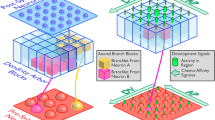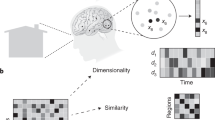Abstract
This report demonstrates the effectiveness of two processes in constructing simple feedforward networks which perform good transformations on their inputs. Good transformations are characterized by the minimization of two information measures: the information loss incurred with the transformation and the statistical dependency of the output. The two processes build appropriate synaptic connections in initially unconnected networks. The first process, synaptogenesis, creates new synaptic connections; the second process, associative synaptic modification, adjusts the connection strength of existing synapses. Synaptogenesis produces additional innervation for each output neuron until each output neuron achieves a firing rate of approximately 0.50. Associative modification of existing synaptic connections lends robustness to network construction by adjusting suboptimal choices of initial synaptic weights. Networks constructed using synaptogenesis and synaptic modification successfully preserve the information content of a variety of inputs. By recording a high-dimensional input into an output of much smaller dimension, these networks drastically reduce the statistical dependence of neuronal representations. Networks constructed with synaptogenesis and associative modification perform good transformations over a wide range of neuron firing thresholds.
Similar content being viewed by others
References
Adelsberger-Mangan DM, Levy WB (1992) Information maintenance and statistical dependence reduction in simple neural networks. Biol Cybern 67:469–477
Adelsberger-Mangan DM, Levy WB (1993) Character recognition using adaptively constructed feed-forward networks. In: Proceedings of the World Congress on Neural Networks, vol II. Erlbaum, Hillsdale, NJ, pp 423–426
Ambros-Ingerson J, Granger R, Lynch G (1990) Simulation of paleocortex performs hierarchial clustering. Science 247:1344–1348
Atick JJ (1992) Could information theory provide an ecological theory of sensory processing? Network 3:213–251
Atick JJ, Redlich AN (1990) Towards a theory of early visual processing. Neural Comput 2:308–320
Atick JJ, Redlich AN (1992) What does the retina known about natural scenes? Neural Comput 4:196–210
Atick JJ, Li Z, Redlich AN (1992) Understanding retinal color coding from first principles. Neural Comput 4:559–572
Attneave F (1954) Informational aspects of visual perception. Psychol Rev 61:183–193
Barlow HB (1959) Sensory mechanisms, the reduction of redundancy, and intelligence. In: The mechanization of thought processes. National Physical Laboratory Symposium No. 10, Her Majesty's Stationery Office, London, pp 537–559
Barlow HB, Földiák P (1989) Adaptation and decorrelation in the cortex. In: Durbin RM, Miall C, Mitchison GJ (eds) The computing neuron. Addison-Wesley, Wokingham, UK, pp 52–74
Bialek W (1989) Theoretical physics meets experimental neurobiology. In: Jen E (eds) Lectures in complex systems. (SFI studies in the sciences of complexity, vol 2) Addison-Wesley, Reading, MA, pp 513–595
Bialek W, Rieke F, de Ruyter van Stevenick RR, Warland D (1991a) Reading a neural code. Science 252:1854–1857
Bialek W, Ruderman DL, Zee A (1991b) Optimal sampling of natural images: a design principle for the visual system? In: Lippmann RP. Moody JE, Touretzky DS (eds) Advances in neural information processing systems, vol 3. Morgan Kaufmann, San Mateo, CA pp 363–369
Field DJ (1987) Relations between the statistics of natural images and the response properties of cortical cells. J Opt Soc Am [A] 4:2379–2394
Földiák P (1989) Adaptive network for optimal linear feature extraction. In: IEEE/INNS International Joint Conference on Neural Networks, vol 1. IEEE Press, New York, pp 401–405
Földiák P (1990) Forming sparse representations by local anti-Hebbian learning. Biol Cybern 64:165–170
Levy WB (1985) An information/computation theory of hippocampal function. Soc Neurosci Abstr 11:493
Levy WB (1989) A computational approach to hippocampal function. In: Hawkins RD, Bower GH (eds) Computational models of learning in simple neural systems. (The psychology of learning and motivation, vol 23) Academic Press, San Diego, CA, pp 243–305
Levy WB, Colbert CM (1991) Adaptive synaptogenesis can complement associative potentiation/depression. In: Commons ML (eds) Neural network models of conditioning: quantitative analyses of behavior, vol 13. Erlbaum, Hillsdale, NJ, pp 53–68
Levy WB, Desmond NL (1985) The rules of elemental synaptic plasticity. In: Levy WB. Anderson JA, Lehmkuhle S (eds) Synaptic modification, neuron selectivity, and nervous system organization. Erlbaum, Hillsdale, NJ, pp 105–121
Linsker R (1987) Towards an organizing principle for a layered perceptual network. In: Anderson DZ (ed) Neural information processing systems. American Institute of Physics, New York, pp 485–494
Linsker R (1988) Self-organization in a perceptual network. Computer 21:105–117
Linsker R (1989a) An application of the principle of maximum information preservation to linear systems. In: Touretzky DS (ed) Advances in neural information processing systems, vol 1. Morgan Kaufmann, San Mateo, CA, pp 186–194
Linsker R (1989b) How to generate ordered maps by maximizing the mutual information between input and output signals. Neural Comput 1:402–411
Linsker R (1990) Perceptual neural organization: some approaches based on network models and information theory. Annu Rev Neurosci 13:257–281
Linsker R (1992) Local synaptic learning rules suffice to maximize mutual information in a linear network. Neural Comput 4:672–683
Miller KD, Keller JB, Stryker MP (1989) Ocular dominance column development: analysis and simulation. Science 245:605–615
Richards DSP, Levy WB (1990) Optimum preprocessing networks and a data processing theorem. In: IEEE/INNS International Joint Conference on Neural Networks, vol 1. IEEE Press, New York, pp 19–22
Shannon CE, Weaver W (1949) The mathematical theory of communication. University of Illinois Press, Urbana, IL
Shepherd G (1979) The synaptic organization of the brain. Oxford University Press, New York
Author information
Authors and Affiliations
Rights and permissions
About this article
Cite this article
Adelsberger-Mangan, D.M., Levy, W.B. Adaptive synaptogenesis constructs networks that maintain information and reduce statistical dependence. Biol. Cybern. 70, 81–87 (1993). https://doi.org/10.1007/BF00202569
Received:
Accepted:
Issue Date:
DOI: https://doi.org/10.1007/BF00202569




